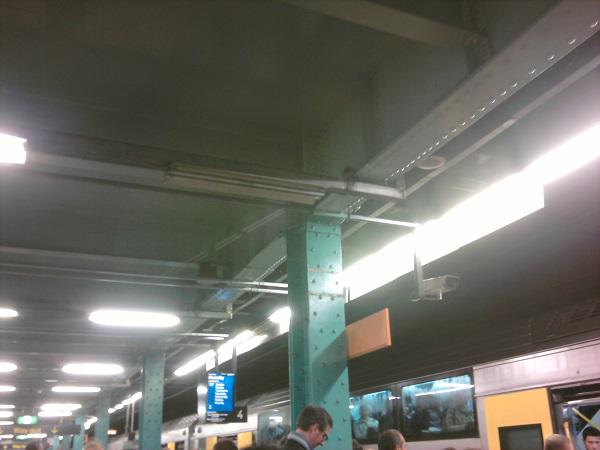The angel who talked with me had a measuring rod of gold to measure the city, its gates and its walls. The city was laid out like a square, as long as it was wide. He measured the city with the rod and found it to be 12,000 stadia in length, and as wide and high as it is long. The angel measured the wall using human measurement, and it was 144 cubits thick. The wall was made of jasper, and the city of pure gold, as pure as glass. The foundations of the city walls were decorated with every kind of precious stone. The first foundation was jasper, the second sapphire, the third agate, the fourth emerald, the fifth onyx, the sixth ruby, the seventh chrysolite, the eighth beryl, the ninth topaz, the tenth turquoise, the eleventh jacinth, and the twelfth amethyst. The twelve gates were twelve pearls, each gate made of a single pearl. The great street of the city was of gold, as pure as transparent glass.
I did not see a temple in the city, because the Lord God Almighty and the Lamb are its temple.
- Revelation 21:15-22
Mrs Rollo and I have been working our way through the book of Revelation and have come to the conclusion that a lot of it is as confusing as all get out. It's kind of nice to know that even the scholars are as confused as all get out because at very least it says that we're not total doofuses.
The questions that we mainly have are "Does this thing happen before or after that thing?", "Do they happen concurrently?", "What does this mean any way?", "Is this something that exists now, or is this something that is yet to come?".
When reading prophetic books, it's often like staring out across a set of mountain ranges, where you know that there must be different mountains out there and they must be varying distances away but in the fog of your current view point and a road that goes somewhere else before you even get there, arguing about which is which is all a bit academic.
The new Jerusalem though, has a pretty concrete sort of description and one that's relatively understood.
It's big.
The new Jerusalem is measured as 12,000 stadia in length.
If we take the Attic standard, as used by Eratosthenes to calculate the circumference of the earth (or shorter depending on who is arguing at the time), the stadia which was made up of 600 pous (which was 308.4mm) was roughly 185.04m long. A distance of 12,000 of those is 2220.48km.
To give you some idea of how far that is away, from Sydney a distance of 12,000 stadia puts you somewhere on the world's longest straight stretch of road, on the Eyre Highway, somwhere in Western Australia.
In relation to the old temple in jerusalem, a distance of 12,000 stadia puts you in the Italian town of Frosinone, which is about 75km southeast of Rome.
It's also worth pointing out that the new Jerusalem is as wide as it is long; so it would cover an area of 4,930,531 km². By itself, that would make it the seventh largest country in the world by area, relegating India at 3,166,414 km² down a spot.
It's also worth pointing out that the new Jerusalem is as high as it is wide, as it is long. The Kármán line which is the arbitrary line of where space begins is only 100km and at 2220.48km, more than 2100 are in space. This means to say that the International Space Station and all of the satellites whizzing about above out heads at the moment, would still easily fit into the lower half of where the new Jerusalem juts into space.
At 144 cubits thick, we're talking about walls which are roughly 216 feet thick. To put that into perspective, the Aurelian Walls which encircled Rome and built under Aurelian and Probus c.271-275CE are roughly 11 feet thick. Even the thickest parts of the Great Wall of China (which is actually a series of non-contiguous walls) are only about 30 feet think; so the walls of the new Jerusalem are not quite seven times as thick as that.
But that's not even the most impressive thing about the new Jerusalem as far as I'm concerned. For that we need to look at the construction of the old temple.
He prepared the inner sanctuary within the temple to set the ark of the covenant of the Lord there. The inner sanctuary was twenty cubits long, twenty wide and twenty high. He overlaid the inside with pure gold, and he also overlaid the altar of cedar. Solomon covered the inside of the temple with pure gold, and he extended gold chains across the front of the inner sanctuary, which was overlaid with gold. So he overlaid the whole interior with gold. He also overlaid with gold the altar that belonged to the inner sanctuary.
- 1 Kings 6:19-22
The inner sanctuary described here or the The "Kodesh Hakodashim" (The "Most Holy Place") is also described as a cube; being twenty cubits long, wide and high. That works out to be about a 30 foot cube.
This "Kodesh Hakodashim" was considered to be the dwelling-place of the "name" of God.
It's kind of a strange concept to think about that the Temple was supposed to be God's fixed house, if that were possible.
When the nation of Israel wandered throughout the wilderness, they were accompanied by the presence of God himself in a cloud by day and a pillar of fire by night. The Tabernacle (which confusingly comes from the Latin tabernaculum) was in Hebrew the "mishkan" or "dwelling place". I suppose that once a permanent city had been established, the idea that the kind should live in a nice house and God didn't, seemed somewhat out of place.
In the book of Ezekiel, in chapter 10; following the destruction of the city of Jerusalem, we read that "the glory of the Lord departed from over the threshold of the temple". I find it particularly chilling that the presence of the Lord in the temple is never mentioned again in any of the Tanakh and only fleetingly in the New Testament.
In as many words, God leaves the house which was built for him and his presence never returns to it.
The tearing of the veil in the gospels is significant because it does spell the return of the ability of people to meet with God but that the temple itself is no longer necessary. When Jesus spoke about tearing down and rebuilding the temple in three days, he speaks about his own body and the apostle Paul wrote to the church in Corinth:
Don't you know that you yourselves are God's temple and that God's Spirit dwells in your midst?
- 1 Corinthians 3:16
This however does not in any way even imply that God's presence returns to the twice destroyed temple in Jerusalem.
The new Jerusalem coming out of heaven in Revelation is said to have no need of a temple "because the Lord God Almighty and the Lamb are its temple" but I still can't help notice the similarities between the description of the city as being a giant golden cube, which seems very close in description to the The "Most Holy Place" of the temple that Solomon built.
More impressive than the giant golden cube of a city is the implication that this massive place will once again fulfil the function of the "mishkan" or "dwelling place" of God with mankind. The very point of the giant golden cube city is the embodiment of the words "I will be their God and they will be my people*".
Surely your goodness and love will follow me all the days of my life, and I will dwell in the house of the LORD forever.
- Psalm 23:6
Literally IN house of the LORD forever.
*There are loads of cross references for this. Pick one:
Jeremiah 31:33
Ezekiel 37:27
2 Corinthians 6:16
Hebrews 8:10
Exodus 29:45
Jeremiah 32:38
Ezekiel 11:20
Revelation 21:3
Leviticus 26:12
Zechariah 2:10-11
Ezekiel 37:26-27
Jeremiah 31:33
Hosea 2:23
Revelation 21:7
Jeremiah 24:7
Genesis 17:7-8
Zechariah 8:8
Zechariah 13:9
Ezekiel 36:28






